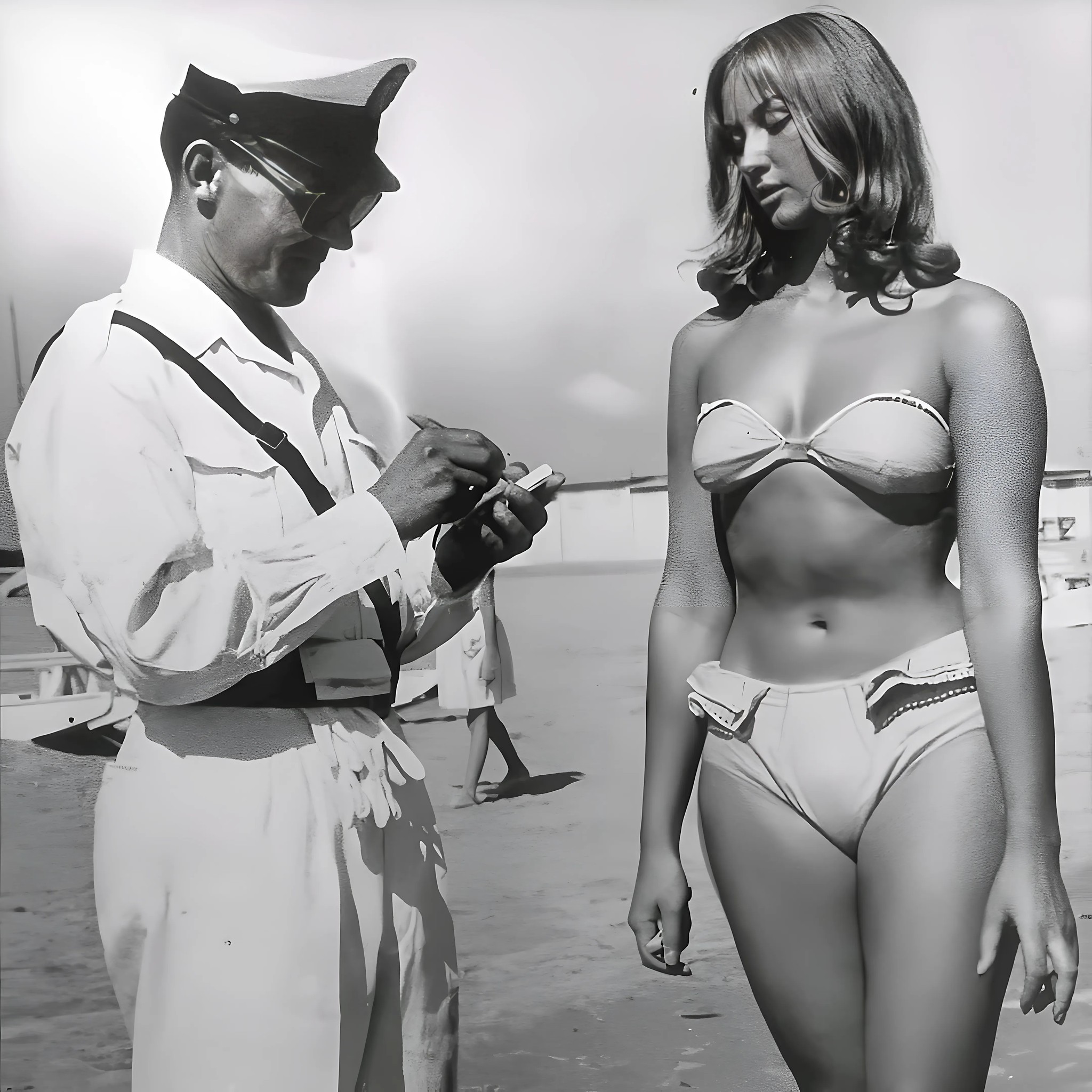One tiny article of clothing. That’s all it took to spark outrage, bans and even arrests around the world.
In the decades-long war between modesty and freedom, the bikini proved to be both the villain and the winner. Popes have called it sinful. Governments outlawed it.
But women continued to wear it – and rewrote the rules with each daring appearance.
Tailors on the beaches
At the dawn of the 20th century, swimwear was a far cry from the sleek and stylish designs we know today. Back then it was a bulky garment made of wool, designed to protect you from the sun. It was not about fashion, but about modesty.

A strict dress code was commonplace on beaches across the United States. As Kathleen Morgan Drown and Patrick Huber write in their book on 1920s pop culture, places like Chicago’s Clarendon Beach even hired tailors to adjust swimming costumes deemed too revealing on the spot.
Similar rules appeared across the country – for example, Coney Island in 1915 banned bathing socks if they exposed ‘knee dimples.’ In Washington, D.C., beach police were known to enforce these rules with a tape measure in hand.
Arrested for a one-piece swimming costume?
In the early 1900s, everyone was eager to cover up. Both men and women had to wear suits from neck to knee – no exceptions. If skin was exposed? It was considered scandalous.
But change was on the horizon. In 1907, Australian swimmer Annette Kellerman became one of the first to challenge these norms by wearing a one-piece suit that exposed her arms, legs and neck instead of the then-standard knickers.
Nicknamed the ‘Australian Mermaid’ for her outstanding swimming skills, Kellerman spent much of her life challenging societal norms and redefining ideals.
According to Kellerman herself, she was arrested by police for her ‘indecent’ attire, although there are no official reports confirming this. Nevertheless, it caused an uproar at the time – a woman was swimming in such an outfit. The incident made headlines and sparked a movement.
Kellerman’s bold swimming costume choice caught the public’s attention, and soon her one-piece suits became a popular trend.
Demand grew so much that she eventually launched her own swimwear line, and ‘Annette Kellerman,’ as they became known, was the first step in the evolution of modern women’s swimwear.

The Roaring 20s: The New Wave of Fashion
In the 1920s, flapper style began to gain momentum not only in evening wear, but also on the beach.
It all started when a group of rebellious women from California rebelled against tradition. Known as the ‘girls in skirts,’ their revolutionary goal was simple: swimming costumes that women could actually swim in.
Thus, swimwear began to change, becoming more practical and form-fitting. ‘Girls’ skirts’ symbolised a nationwide shift that was not only about fashion, but also about functionality and freedom of movement.
Although still modest by today’s standards, women gradually showed more skin and swimwear was designed for freedom of movement. But the real revolution was yet to come.
The Bikini: A Scandalous Step Forward
The year was 1946, and with it came the birth of the bikini. Invented by French engineer Louis Reard, this two-piece swimming costume exposed the navel and exposed more skin than anyone thought appropriate for public places.
Just days before the bikini was introduced in 1946, the US conducted the first peacetime nuclear test at Bikini Atoll, which caught the world’s attention.
Although designer Louis Réard never explained why he named the swimming costume ‘bikini,’ many believe it was an allusion to the explosive effect he hoped it would produce – both commercially and culturally – like the bomb itself. Others suggest the name conjured up thoughts of the exotic appeal of the Pacific, or compared the shock of a revealing swimming costume to the power of an atomic explosion.
The reaction in the US was swift: many beaches banned bikinis and it was seen as outright rebellion. In Europe, things were not much simpler. France banned bikinis on its beaches in 1949, and in Germany they were banned in public swimming pools until the 1970s. At the same time, some communist groups condemned bikinis as a sign of capitalist decadence and moral decay.
Pope Pius XII declared the bikini sinful, and several countries, including Belgium, Italy, Portugal, and Spain, imposed nationwide bans on swimwear.
A famous case occurred in 1952 when Australian model Anne Ferguson was asked to leave the beach at Surfers Paradise because her Paula Stafford bikini was deemed too revealing.
The truth about the famous photo
One photo has come to symbolise the whole debate about whether or not bikinis can be worn on public beaches. And it comes from Italy.
The black and white photo, which has gone viral in recent years, shows a man in a white uniform standing next to a young woman in a bikini on a beach. Social media users often claim that the moment was captured in Rimini, Italy in 1957. The most common version of the story says that the man is a police officer writing the woman a ticket for simply wearing a bikini.
In 2023, a post with this image appeared on Reddit, garnering over 31,000 votes and 1,400 comments. The caption read: ‘Police officer writing a ticket to a woman for wearing a bikini, 1957.’
But was it real?
The photo itself is genuine – it shows no signs of digital processing – but the backstory remains a mystery. There is no hard evidence that the woman was fined for the swimming costume. Some suspect it may have been a staged scene involving models or actors, while others believe the police officer may have ticketed her for an entirely different reason.
Nevertheless, the photo has struck a nerve.
Gianluca Braschi, director of the Rimini State Archives, confirmed to Snopes in an email that Italy did indeed have swimming costume laws at the time, though the story behind the photo remains unclear.
As Braschi explained, a 1932 law prohibited ‘bathing in public in a state of total nudity and in obscene swimwear.’ That law technically remained in effect until 2000, though enforcement was inconsistent.
So while we may never know the full story behind this viral moment, it reflects the very real tensions of that era, when bikinis didn’t just attract attention… they could also get you in trouble.
Hollywood’s Influence
It wasn’t until the 1960s that the bikini became truly popular. Cultural shifts opened the door to bolder swimming costume styles.
But even then, public opinion was divided. More conservative neighbourhoods opposed the tiny two-parter.

One example is the U.S. Motion Picture Code, better known as the Hayes Code, which was enacted in 1934. It allowed two-piece outfits in films, but strictly forbade showing the navel. The National Legion of Decency, a Roman Catholic group, urged Hollywood and international filmmakers to completely reject bikinis on the big screen.
The emergence of Hollywood stars like Marilyn Monroe, Ursula Andress and Brigitte Bardot helped redefine standards of beauty and self-confidence. These icons didn’t just wear swimming costumes – they became synonymous with them.
Bikini Girl
Perhaps no one did more to make the bikini gain worldwide popularity than French-born actress Brigitte Bardot.
It wasn’t just the fact that she wore a bikini, it was the way she wielded it. In her breakthrough role in The Bikini Girl, Bardot didn’t just wear a swimming costume, she turned it into a cultural statement. Her figure, clad in a strapless diamond-shaped bikini that looked like it could come undone at any moment, became the centrepiece of the film.
With her long, wispy hair and carefree appearance, Bardot wasn’t just acting – she was rewriting the rules for how women were seen on screen.
The film tried to show her in harmony with the ocean and the sun, but let’s be honest: it was her body that the camera adored. She appeared in the film in classic pin-up style, but Bardot wasn’t just a treat for the eyes – she was the first actress to star in a bikini in a leading role and gave it a storyline.
Brigitte Bardot in a white bikini stands on a rocky beach in footage from the film The Girl in the Bikini, directed by Willy Rosier, 1958. (Photo: Atlantis Films/Pictorial Parade/Courtesy of Getty Images)
While Bardot wasn’t the first woman to wear a bikini, she was the first to make the bikini iconic thanks to the story, and thanks to this film in the US, she gained instant worldwide fame.
Ursula Andress’ white bikini from the film Dr No (1962) instantly became an icon because it combined sex appeal, power and cinematic impact that audiences had never seen before.
As she emerged from the sea with a knife strapped to her hip, Andress wasn’t just eye-catching – she was strong, confident and unforgettable. This moment defined her as the ultimate Bond girl and cemented the bikini as a symbol of bold femininity in pop culture.
In the 1970s, bikinis were everywhere. Swimwear became even more revealing, with thong bikinis and thong panties entering the scene. Men’s swimwear also shrank as the ‘modesty’ of the early 20th century became a thing of the past.

Swimming costumes Today: Bodypositive and Diversity
In the 21st century, swimwear no longer just conforms to societal norms. The swimwear market has become a world of choice.
From modest one-piece swimming costumes to bikini thongs and daring thongs, there is something for everyone. What’s more, the conversation about body types has changed dramatically. Today, it’s about comfort, confidence and body positivity, and people of all shapes, sizes and backgrounds are free to express themselves on the beach or in the pool.
Gone are the days when ‘decent’ swimwear was regulated. Now it’s all about personal choice and self-expression. Whether it’s a full-zip swimming costume or the most revealing bikini, America’s changing views on modesty reflect a much more inclusive and accepting society.
What started as a fight for modesty has turned into a celebration of diversity, individuality and freedom. So the next time you head to the beach, remember: it’s not just about the swimming costume – it’s about the path to self-expression it represents.





















